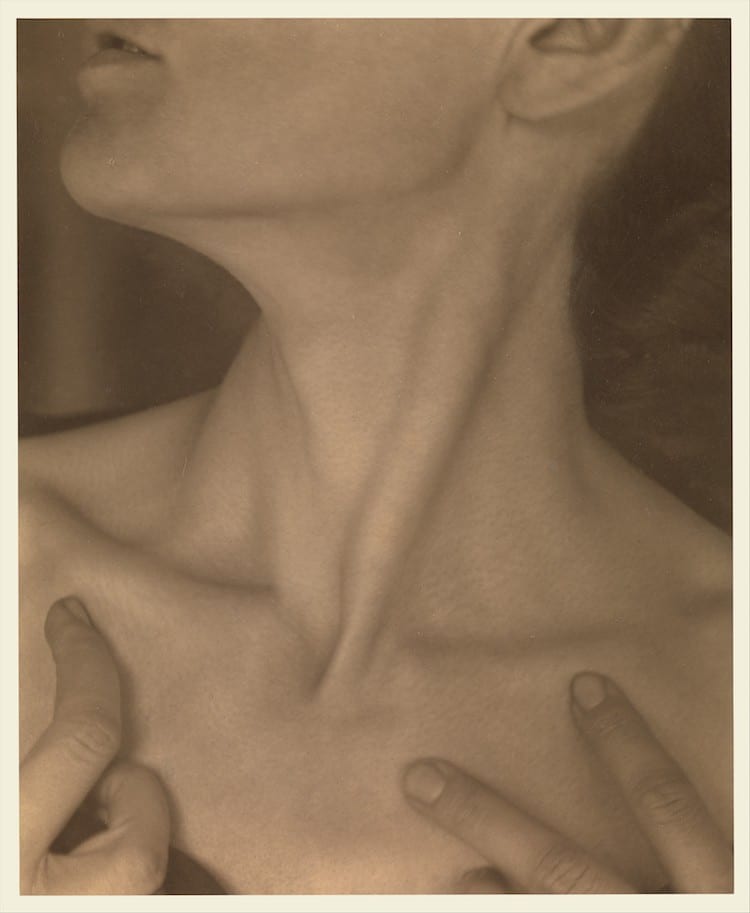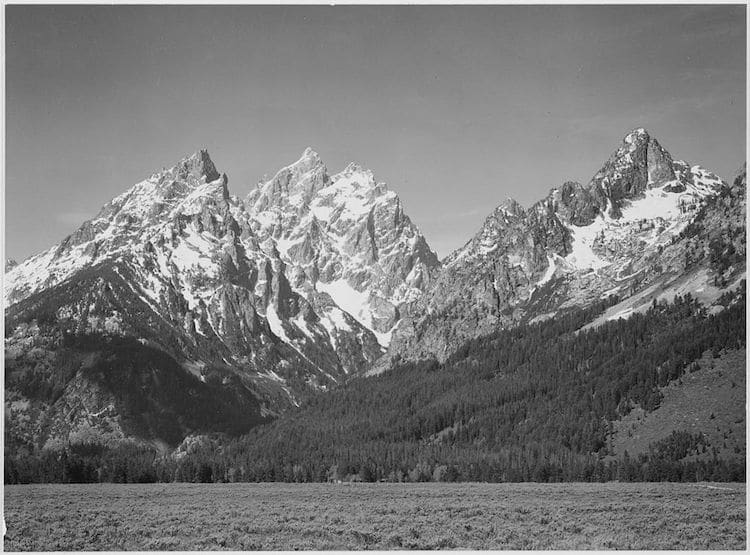
Alfred Stieglitz. Georgia O’Keeffe – Neck. 1921. Metropolitan Museum of Art
This is in direct opposition to documentary photography fields, like standard photojournalism, which acts more as visual report, recording the scene without manipulation. Fine art photographers are artists who use photography as a medium, either on its own or incorporated into their artwork through collage.
So, really, fine art photography runs contrary to what most of us think about when thinking about how we use a camera. Most amateur photographers use their cameras to document important events and capture memories without artistic motivation. Instead, a distinguishing feature of fine art photography is that recording a subject is not the main purpose. These artists use photography as a means to express their vision and make an artistic statement.
Ansel Adams once stated, “Art implies control of reality, for reality itself possesses no sense of the aesthetic. Photography becomes art when certain controls are applied.” What exactly does this mean? Here, Adams taps into how artists have historically manipulated reality as a means to an end.
For instance, even classical landscape painters did not simply paint exactly what they saw in front of them. Many subtly included, or excluded, elements that distracted from their message or, like Monet, worked with light and color to exude a mood. Fine art photographers work in the same manner, simply using a camera instead of a brush.
Coming into the 21st century, the field has greatly expanded and now any photograph that has an artistic intent behind it can often be considered fine art. This includes artistic documentary photography by renowned photojournalists.
Thus, when trying to understand if a photograph should be considered art, it’s always important to understand the intent of the photographer. If there is an underlying artistic message, then it will be considered fine art photography, whether it’s a landscape, portrait, or abstract photo.
Alfred Stieglitz and the Development of Photography as Art
While it may be difficult to imagine a time when photography wasn’t considered an art form, this was the case in the late 19th- and early 20th-century. We can thank artist Alfred Stieglitz and other modernist photographers for helping move photography toward consideration as a fine art. Stieglitz, in particular, was already pushing this idea at the end of the 19th century, even publishing an article on the topic.
Another milestone came in the early 20th-century when Stieglitz’s photographs were exhibited alongside paintings by artists like Mary Cassatt and James McNeill Whistler. The show, titled Special Exhibition of Contemporary Art, was organized by the National Arts Club and is thought to be the first major American exhibition which gave equal billing to photographers and painters.
Later, Stieglitz and his wife Georgia O’Keefe were responsible for getting photography into museum collections, a huge feat at a time when the medium was not on equal footing. In fact, Stieglitz’s donation of 27 photographs to the Boston Museum of Fine Arts in 1924 was the first time a major museum accepted photography into its permanent collection.

Alfred Stieglitz. Equivalents. 1928. Metropolitan Museum of Art
Fine Art Photographers Who Define the Medium
What Stieglitz started, many others carried on, each in their own, distinct manner. From the lush black and white landscapes of Ansel Adams to the groundbreaking work of Nan Goldin, here is a look at the famous fine art photographers who helped push the genre forward.
Paul Strand

Paul Strand. The White Fence. c. 1917. (via Wikicommons)
American photographer Paul Strand was highly active in promoting photography as an art form, with Stieglitz even exhibiting his work in his gallery and writing about his photography in his publication Camera Work.
He often experimented with using the camera to create abstraction in his images and embraced ideas similar to painters and sculptors, simply applying them to his photography. He later turned his focus on how photography could be a tool for social change and reform, yet always retained his artistic vision across his career, which spanned six decades.
Man Ray
As a significant contributor to the Dada and Surrealist movements, Man Ray‘s work spanned a wide variety of media. His ability to move seamlessly between painting and photography, giving them equal value in his repertoire, helped break stigma against photography as fine art.
Indeed, his artistic eye greatly informed his commercial work, where he specialized in portrait and fashion photography. He also experimented with photograms as a form of expression.
Ansel Adams

Ansel Adams. Grassy valley, tree covered mountain side and snow covered peaks, Grand “Teton National Park”, Wyoming. 1941. National Archives Catalog
No discussion of landscape photography would be complete without including the legendary Ansel Adams. As a photographer and conservationist, his black and white landscape photography demonstrates that many different genres can be considered fine art.
Adams’ careful compositions and his ability to open up nature, giving viewers a different viewpoint on the landscape, elevate his work. He proved that nature photography could not only have an impact on conservation issues, but could also compete as high art.

Ansel Adams. “The Tetons – Snake River,” Grand Teton National Park, Wyoming. 1941. National Archives Catalog
Richard Avedon
American fashion photographer Richard Avedon used his camera not only to capture models in elegant attire, but to tell stories and evoke emotions. From his minimalist, large-scale portraits that reveal the inner emotions of celebrities like Marilyn Monroe, to bringing model Dovima out of the studio and into the circus, his work revolutionized the industry.
Diane Arbus
Diane Arbus’ work, which focused on marginalized people, gave voice to those who were considered ugly or imperfect. Circus performers, dwarves, nudists, and transgender people were all subjects of her work, which has been characterized as surreal.
Though she was considered a documentary photographer, artistic elements are always present in her work, which was met with success in her lifetime. In 1967 she participated in an exhibition at the MoMA in New York and that institution, as well as the Metropolitan Museum of Art, purchased several photographs for their collection. In 1972, one year after her death, she became the first photographer to exhibit at the prestigious Venice Biennale.
Cindy Sherman
Cindy Sherman uses her photography as a means to act out a range of situations, using herself as her primary model. More than standard self-portraits, Sherman disguises herself, acting as photographer, costumer, makeup artist, and director to set up tableaus that range from bored housewife to Hollywood actress.
With a career spanning over 30 years, Sherman is widely considered one of the top artists in the contemporary art field. Her work acts as an illusion, for its seeming realism is actually a highly planned out ode to artifice.
Robert Mapplethorpe
In the 80s, his work evolved into focusing on still life images of flowers and statuesque nudes that appear influenced by classical art. He was also instrumental in influencing a love of photography as fine art in his partner and benefactor Sam Wagstaff, who sold off his collection of paintings in order to begin collecting photography. This collection was later sold to the J. Paul Getty Museum for a report $5 million.
Nan Goldin
Starting with her first solo show in 1973, Nan Goldin has always used her camera to document the lives of those she loved, focusing primarily on the LGBT community. Photographed without judgment, her images of everyone from drag queens to drug addicts is a raw depiction of life.
Goldin’s work is often presented as slideshows set to music, such as her most famous work The Ballad of Sexual Dependency, which debuted at the Whitney Museum of American Art. Consisting of images taken between 1979 and 1986 in Goldin’s Bowery neighborhood, it was controversial for its unflinching depiction of heroin addiction and gay culture in a post-Stonewall New York.
Jeff Wall
Canadian fine art photographer Jeff Wall is known for his large scale photographic tableaux. His early work was influenced by the great painters of art history, such as Velázquez and Manet, has he made subtle references to their works through his compositions.
Wall’s work has evolved over time, with him experimenting widely on how photography can be manipulated. His work Milk was part of a series of seemingly mundane, candid images that were, in actuality real life incidents later restaged with non-professional actors for cinematic effect. Since the 90s, Wall has become increasingly interested in digital manipulation, using laying multiple images within one final, composite composition.
Andreas Gursky
Andreas Gursky, widely hailed as one of the top fine art photographers of the 21st century, is known for his monumental photography. His work Rhine II was auctioned in 2011 for $4.3 million, making it the most expensive photograph ever sold.
Using scale to place his work on the level of the Old Master painters, the German photographer captures architecture and nature from unique angles that highlight the symmetry and color that elevate the subject. Gursky has also begun incorporating digital manipulation into his practice, using this to emphasize certain characteristics, such as spaces that are too large to be natural. His 6-foot by 8-foot image Times Square, New York from 1997 is a good example of a space that is real, but has been manipulated to achieve Gursky’s artistic vision.
John Goto

John Goto. High Summer. 2001.
John Goto defines himself as a photo-digital artist, using photography to create digital collages about social and political themes. Often irreverent and satirical, Goto’s work creates a strong narrative through its layers of imagery.
In 2007 the Telegraph listed him as one of the top 100 living geniuses. Coming from a background in painting, Goto started off with traditional photography before transitioning into digital art. He is a firm believer “that digital technology has created a synthesis between forms of painting and photography.”
Related Articles:
How Abstract Photography Has Evolved and Still Continues to Inspire Art
The History of Photojournalism. How Photography Changed the Way We Receive News.
11 Very Different Types of Photography That Each Illuminate Our World
16 Famous First Photographs in History: From the Oldest Photo Ever to the World’s First Instagram
